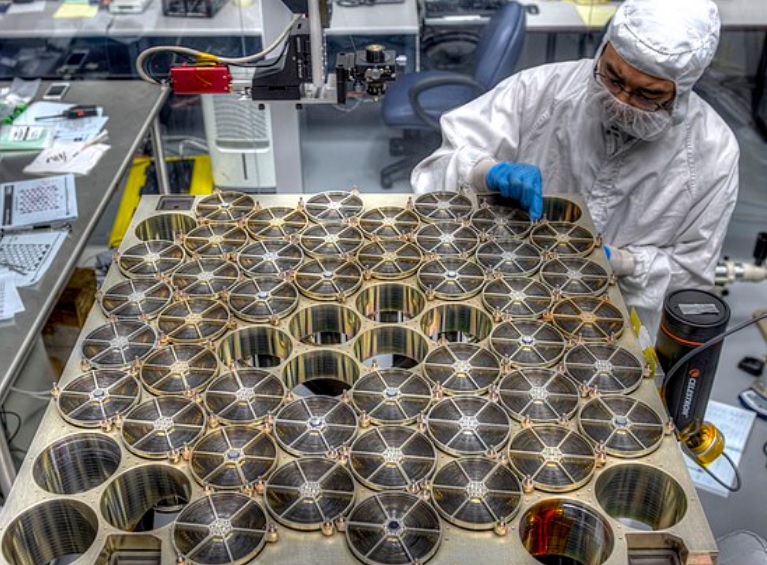NICER and SEXTANT demonstrate XNAV pulsar navigation system that may be used on Artemis.

NASA
As long as explorers have traversed Earth's surface, getting an accurate fix on location has been essential. Early explorers used a sextant and compass to gauge the position of the stars at sea, and modern travelers use satellite-enabled GPS technology. Now, future deep space missions may use a more exotic source to get a fix on their location: the beating hearts of dying stars, known as pulsars.
Pulsars, also referred to as neutron stars, are the swiftly spinning remnant cores of core-collapse supernovae. A famous example is the pulsar at the center of the Crab Nebula, or Messier 1, in Taurus. Discovered in the late 1960s, the ultra-precise signals from pulsars earned them the informal acronym LGM (for "Little Green Men") for a short time after their discovery.
NASA's Neutron star Interior Composition Explorer (NICER) instrument, which has operated on the International Space Station (ISS) for the past few years, is devoted to studying pulsars to understand their structure and evolution. A technology demonstration known as SEXTANT utilizes those observations as a test-bed for future pulsar-based navigation.
NICER is a large, box-shaped detector, located on the exterior of the Integrated Truss Structure of the ISS. Part of NASA’s Explorers program, NICER records X-ray photons with energies between 200 and 12,000 electron volts. The detector was deployed as a proof of concept in 2017 and demonstrated X-ray detection and navigation capability in 2018.
Along the way, NICER has discovered the brightest X-ray burst from a pulsar 11,000 light-years away in Sagittarius, and found the fastest known orbiting pulsar orbiting its companion star every 38 minutes.

NASA / NICER
With SEXTANT, the mission turns the detector's pulsar timings — particularly timing measurements of rapidly rotating millisecond pulsars — into an autonomous next-generation navigation system for accurate positioning throughout the solar system.
Enter XNAV
NICER observes specific pulsars during each 90-minute orbit around Earth. By comparing time-stamped arrival times of the pulsars' photons, the SEXTANT program measures the station’s precise position in space. This X-ray pulsar-based navigation is sometimes referred to as XNAV.
XNAV takes GPS to the next level, turning the "G" from "global" into "galactic."
“GPS uses precisely synchronized signals,” says Luke Winternitz (NASA Goddard Space Flight Center) in a recent press release. “Pulsations from some neutron stars are extremely stable, some even as stable as terrestrial atomic clocks in the long term, which makes them potentially useful in a similar way.”
Robotic missions in the solar system typically use a combination of star tracking and radio signals from NASA’s worldwide Deep Space Network to fix position. XNAV would give a mission an autonomous and accurate navigational system that doesn't degrade as the mission travels farther from Earth.

NASA / GSFC
One advantage to XNAV is that it would work throughout the solar system — and beyond — with no delay due to intervening interstellar matter. X-ray signals, however, are fainter, so the technique requires a more robust detector.
XNAV and Artemis
There are also plans to use the system on the upcoming Artemis initiative, which will return astronauts to the Moon. The planned Lunar Gateway will orbit the Moon in a looping 6 ½-day near-rectilinear halo orbit, allowing for longer and more accurate pulsar observations.
A longer collection time also means that a NICER/SEXTANT-type system on board the Lunar Gateway platform could be much smaller that the one currently used on the exterior of the International Space Station. “NICER is roughly the size of a washing-machine, but you could dramatically reduce its size and volume,” says Jason Mitchell (NASA Goddard Space Flight Center) in a recent press release. “For example, it would be interesting to fit an XNAV telescope into a small satellite that could independently navigate the asteroid belt and characterize primitive solar system bodies.”
Classic sextant navigation has actually been a mainstay in crewed U.S. spaceflight in the past, going all the way back to the Gemini and Apollo missions. On Apollo 8, Jim Lovell demonstrated that such a method could be used as a backup for astronauts to find their way back to Earth in the event of an emergency. In 2018, ISS astronauts tested a similar technique for possible future use by Orion deep space missions. And the U.S. Navy even brought the method of stellar navigation back for officer training in the event of a contingency. Although the pulsar method is more exotic, it would give deep space missions an autonomous means of navigation.
Pulsar navigation may one day come as standard feature of future space missions.
 5
5









Comments
Anthony Barreiro
June 30, 2020 at 3:52 pm
Jim Lovell also used a sextant sight of the Earth's terminator to point Apollo 13 at the correct reentry angle, so that the spacecraft wouldn't either skip off back into space, or burn up by coming in too steeply.
https://www.universetoday.com/62763/13-things-that-saved-apollo-13-part-6-navigating-by-earths-terminator/
And celestial navigation is still practiced by many sailors. Celestial navigation is a prudent complement and potential back up to GPS, coastal piloting, and dead reckoning; a way to personally experience and appreciate the history of navigation; and a deeply rewarding skill to learn and master.
You must be logged in to post a comment.
John-Murrell
July 4, 2020 at 4:00 am
For Celestial Navigation you need an accurate clock, I hope they have accurate clocks that are independent of GPS. Some of the radio signals use the GPS time distribution to ensure accuracy or at least as a cross check.
Perhaps it is time for having clocks based on pulsar timing on the surface of the Earth ?
You must be logged in to post a comment.
OldDogZeroOne
July 4, 2020 at 8:04 am
John,
I think the main problem with pulsar nav on Earth would be the fact that x-rays don't penetrate the Earth's atmosphere. That leaves radio, which requires a large antenna compared to GPS reception which fits in your smart phone!
You must be logged in to post a comment.
Anthony Barreiro
July 5, 2020 at 7:25 pm
John, an inexpensive digital watch provides accurate time for celestial navigation. If you carry two or three watches, you don't need to worry as much about all their batteries dying at the same time. My Timex runs one second fast every nine days. So even if I didn't have a GPS or radio time signal, I would just remember to subtract one additional second every nine days.
If your time is correct within four seconds, you can find your position within one arcminute of longitude. That equates to one nautical mile (1.852 km) at the equator, and progressively shorter distances at higher latitudes. Other sources of error, especially measuring the height of the Sun or other celestial object above the horizon and the time it takes to look from your sextant to your watch to note the time, typically introduce more uncertainty than clock calibration errors.
It would still be cool if my Pulsar watch really got the time from pulsars!
You must be logged in to post a comment.
pswilson1
July 2, 2020 at 10:51 am
Well, it's unlikely to matter in the near term.
When regaining power, the Left will cut NASA to the bone as they have always done. The funds will be redistributed to the welfare state.
It will be totally on the backs of private firms like SpaceX until they can likewise be drained of all resources.
You must be logged in to post a comment.
You must be logged in to post a comment.